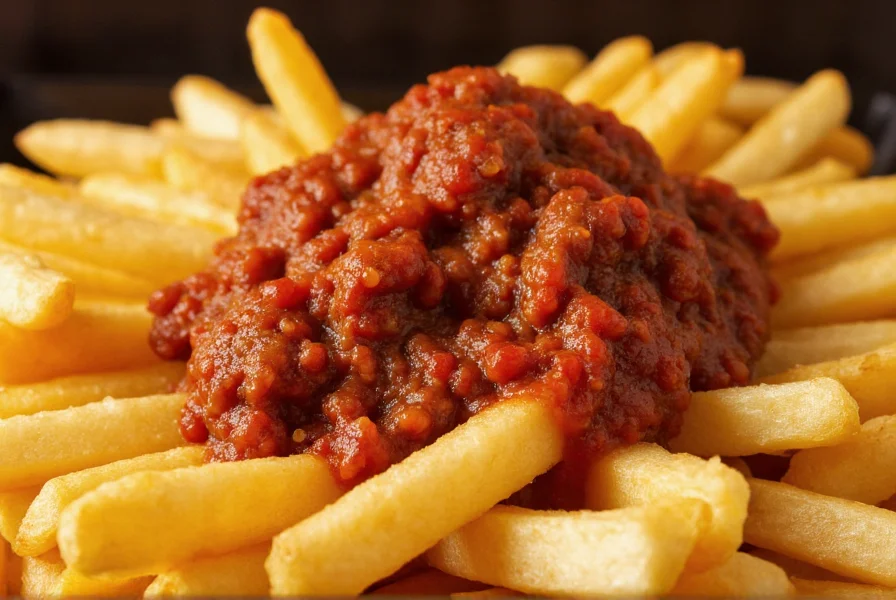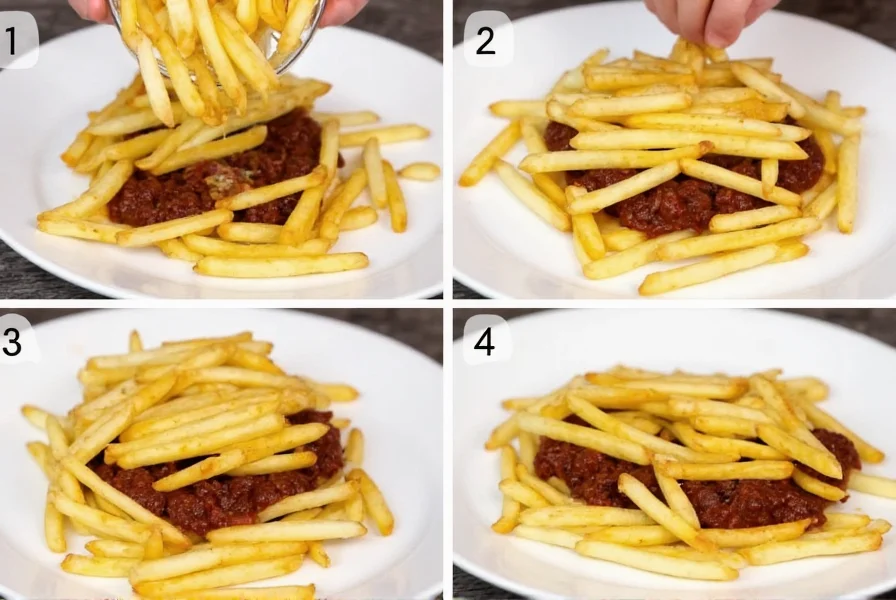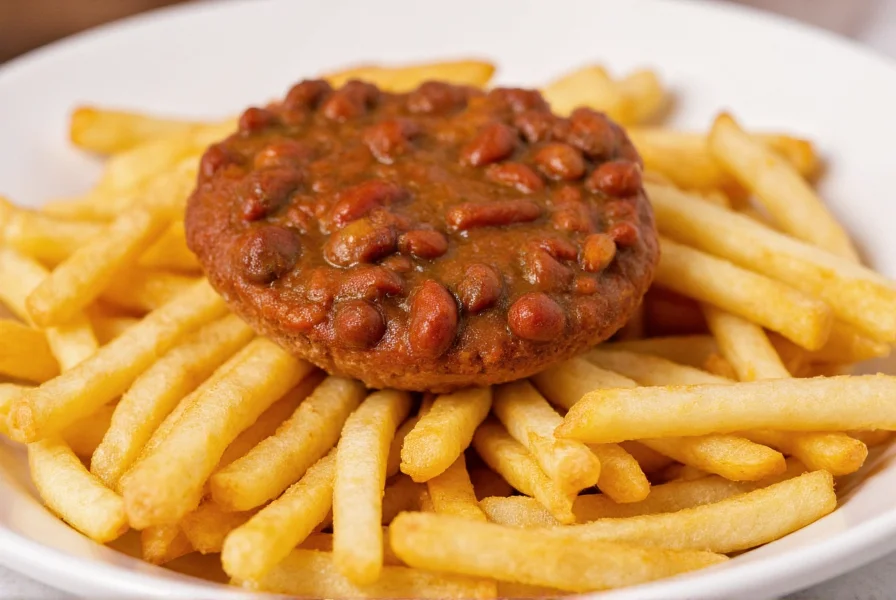Originating in mid-20th century American diners, fries with chili has evolved from a simple comfort food into a beloved menu staple with regional variations that reflect local tastes and culinary traditions. This satisfying combination transforms ordinary French fries into a complete meal through the addition of savory chili, offering both texture contrast and flavor complexity that keeps diners coming back for more.
The Essential Components of Authentic Fries with Chili
Creating perfect fries with chili requires attention to both elements of this classic pairing. The foundation lies in properly prepared French fries—crispy on the outside, fluffy on the inside, and seasoned immediately after frying. For the chili component, traditional recipes feature:
- Ground beef (80/20 fat ratio for optimal flavor)
- Tomato base (diced tomatoes or tomato sauce)
- Onion and garlic for aromatic depth
- Worcestershire sauce for umami enhancement
- A balanced spice blend (chili powder, cumin, paprika)
- Optional kidney or pinto beans for added texture
What distinguishes true fries with chili from similar dishes like chili cheese fries is the absence of melted cheese as a primary component. While cheese might be offered as an optional addition, the core experience centers on the interplay between crispy potatoes and robust chili.

Regional Variations Across North America
As this dish spread across the United States and Canada, local interpretations emerged that reflect regional preferences:
| Region | Distinctive Features | Common Additions |
|---|---|---|
| Midwest | Thicker chili with visible meat chunks | Shredded cheddar, sour cream |
| Southwest | Spicier chili with green chilies | Jalapeños, cilantro, lime |
| East Coast | Thinner, soupier chili consistency | Raw onion, hot sauce |
| West Coast | Bean-heavy chili, often vegetarian | Avocado, pickled onions |
Perfecting Your Homemade Fries with Chili
While restaurant versions satisfy cravings, creating exceptional fries with chili at home requires specific techniques that many home cooks overlook. The key to success lies in preparation sequence and temperature management.
First, prepare your chili at least 30 minutes before frying the potatoes. This allows flavors to meld while preventing the fries from becoming soggy while waiting for the chili. Use a cast-iron skillet for frying to maintain consistent oil temperature between batches. When assembling, spread fries on a paper towel-lined plate first to absorb excess oil, then immediately top with hot chili.
Avoid the common mistake of mixing chili directly with fries, which destroys the crucial textural contrast. Instead, layer the chili generously on top, allowing each bite to contain both elements while maintaining the fries' crispness as long as possible.

Modern Interpretations and Dietary Adaptations
Contemporary chefs and home cooks have expanded traditional fries with chili to accommodate various dietary preferences without sacrificing flavor. Successful adaptations include:
- Vegan versions using textured vegetable protein or lentils instead of beef, with smoked paprika providing meaty depth
- Gluten-free preparations ensuring all chili ingredients (including Worcestershire sauce) meet dietary requirements
- Low-sodium options using fresh tomatoes and reduced-sodium broth while boosting flavor with additional spices
- Extra-spicy variations incorporating chipotle peppers or habanero for heat enthusiasts
These thoughtful adaptations demonstrate how fries with chili has evolved while maintaining its essential character. The dish's flexibility explains its enduring popularity across changing culinary landscapes.
Pairing Suggestions for Complete Dining Experience
Fries with chili works as both a standalone meal and part of a larger dining experience. Consider these complementary pairings:
- Cold lager or amber ale cuts through the richness
- Simple green salad with vinaigrette provides freshness
- Cornbread or biscuits absorb excess chili while adding sweetness
- For brunch service, a fried egg on top transforms it into a hearty morning meal
When serving fries with chili at home, prepare all components separately and assemble just before serving to maintain optimal texture. Keep extra napkins handy—this beloved dish is deliciously messy!
What's the difference between fries with chili and chili cheese fries?
Fries with chili features French fries topped with meat-based chili as the primary component, while chili cheese fries specifically includes melted cheese as an essential element. Traditional fries with chili may offer cheese as an optional addition but doesn't require it, focusing instead on the chili-fry combination.
Can I make fries with chili vegetarian?
Yes, you can create excellent vegetarian fries with chili by substituting the ground beef with textured vegetable protein, lentils, or a combination of mushrooms and walnuts. Use vegetable broth instead of beef broth and ensure your Worcestershire sauce is vegetarian (many contain anchovies).
How do I prevent my fries from getting soggy with the chili?
To maintain crispness, spread freshly fried potatoes on a paper towel-lined plate first to absorb excess oil. Only then should you top them with hot chili. Avoid mixing the chili into the fries—layer it generously on top instead. Serve immediately after assembly for best results.
What's the ideal consistency for chili served over fries?
The perfect chili for fries should be thick enough to coat the fries without making them soggy, but not so thick that it clumps. It should have a stew-like consistency where the meat and beans are suspended in the sauce rather than swimming in liquid. If your chili seems too thin, simmer it uncovered for 10-15 minutes to reduce and thicken.
How did fries with chili become popular in American diners?
Fries with chili gained popularity in mid-20th century American diners as an affordable, satisfying meal that could be prepared quickly using ingredients restaurants already stocked. Its rise coincided with the post-war economic boom when diners expanded their menus beyond basic sandwiches to include heartier offerings that appealed to working-class customers seeking substantial meals at reasonable prices.











 浙公网安备
33010002000092号
浙公网安备
33010002000092号 浙B2-20120091-4
浙B2-20120091-4